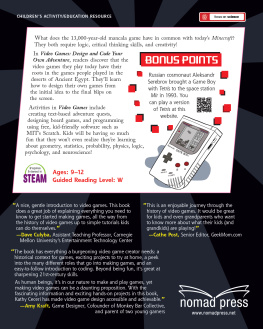Published in 2017 by Cavendish Square Publishing, LLC 243 5th Avenue, Suite 136, New York, NY 10016
Copyright 2017 by Cavendish Square Publishing, LLC
First Edition
No part of this publication may be reproduced, stored in a retrieval system, or transmitted in any form or by any meanselectronic, mechanical, photocopying, recording, or otherwisewithout the prior permission of the copyright owner. Request for permission should be addressed to Permissions, Cavendish Square Publishing, 243 5 th Avenue, Suite 136, New York, NY 10016. Tel (877) 980-4450; fax (877) 980-4454.
Website: cavendishsq.com
This publication represents the opinions and views of the author based on his or her personal experience, knowledge, and research. The information in this book serves as a general guide only. The author and publisher have used their best efforts in preparing this book and disclaim liability rising directly or indirectly from the use and application of this book.
CPSIA Compliance Information: Batch #CS16CSQ
All websites were available and accurate when this book was sent to press.
Library of Congress Cataloging-in-Publication Data Names: Hulick, Kathryn, author.
Title: American life and video games from Pong to Minecraft / Kathryn Hulick. Description: New York : Cavendish Square Publishing, 2017. |
Series: Pop culture. | Includes bibliographical references and index.
Identifiers: LCCN 2016000272 (print) | LCCN 2016012677 (ebook) |
ISBN 9781502619754 (library bound) | ISBN 9781502619761 (ebook) Subjects: LCSH: Video games--Social aspects--United States--Juvenile literature. | Video games--History--Juvenile literature.
Classification: LCC GV1469.34.S52 H85 2017 (print) | LCC GV1469.34.S52 (ebook) | DDC 794.8--dc23
LC record available at http://lccn.loc.gov/2016000272
Editorial Director: David McNamara Editor: Kelly Spence Copy Editor: Nathan Heidelberger Art Director: Jeffrey Talbot Designer: Jessica Nevins Production Assistant: Karol Szymczuk Photo Research: J8 Media
The photographs in this book are used by permission and through the courtesy of: Chris Rand/File:Signed Pong Cabinet.jpg/Wikimedia Commons, cover (Pong), damircudic/iStockphoto.com (girl); Simon Dawson/Bloomberg/ Getty Images, 4; Bletchley Park Trust/SSPL/Getty Images, 8; Public Domain/File:Alan Turing az 1930-as evekben. jpg/Wikimedia Commons, 10; U.S. Army photographer/File:Two women operating ENIAC (full resolution).jpg/ Wikimedia Commons;, 12; ClassicStock/SuperStock, 14; Brookhaven National Laboratory/File:Tennis For Two in 1958. jpg/Wikimedia Commons, 15; NASA/Apollo 11/ File:Buzz Aldrin and the U.S. Flag on the Moon (9460188482).jpg/ Wikimedia Commons, 18; Kenneth Lu ( http://www.flickr.com/people/24226200@N00)/ File:Spacewar screenshot. jpg/Wikimedia Commons, 20; dpaJens Wolf/AP Images, 22; Photo.Zoommer.RU/Alamy Stock Photo, 25; Rob Boudon ( http://www.flickr.com/people/88562024@N00)/ File:Four Arcade Games.jpg/Wikimedia Commons, 26; Carl Mydans/The LIFE Images Collection/Getty Images, 29; Arcade Images/Alamy Stock Photo, 33; Maria J. Avila Lopez/San Jose Mercury News, 35; Scott Canoni/File:Atari Adventure Easter Egg on Atari (Jakks Pacific) Port.jpg/ Wikimedia Commons, 38; File:OregonTrailScreenshot.png/Wikipedia, 40; ArcadeImages/Alamy Stock Photo, 42; ML5/ File:CBM64Cartridges.JPG/Wikimedia Commons, 45; Miguelon756-5303/File:Atari E.T WIKIPEDIA. png/Wikimedia Commons, 49; Evan-Amos/File:NES-Console-Set.jpg/Wikimedia Commons, 51; vanillasky/Alamy Stock Photo, 52; Universal/Courtesy: Everett Collection, 54; Alex Milan Tracy/Sipa via AP Images, 57; Michal Czerwonka/Getty Images, 58; Evan-Amos/File:Sega-Genesis-Power-Base-Converter.jpg/Wikimedia Commons, 63; Finnbarr Webster/Alamy Stock Photo, 64; Arcade Images/Alamy Stock Photo, 67; http://www.nongnu.org/freedoom/ File:Freedoom004 01.png/Wikimedia Commons, 69; AF archive/Alamy Stock Photo, 72; Cyan Worlds/File:Myst-library and ship.jpg/Wikipedia, 74; Jfmdesign/iStockphoto.com, 76; Ethan Miller/Getty Images News/Thinkstock, 82; Picturesbyrob/Alamy Stock Photo, 83; Ian Dagnall/Alamy Stock Photo, 86; ZUMA Press, Inc./Alamy Stock Photo, 89; formicamonkey/iStock/Thinkstock, 92; veryan dale/Alamy Stock Photo, 95; Patrick Fallon/Bloomberg/Getty Images, 97.


Opposite: Video gaming is a major entertainment industry. Today, many people enjoy playing games such as Candy Crush Saga on mobile devices.
THE URGE TO PLAY GAMES IS AN ESSENTIAL part of human nature. Pretend play, board games, card games, and sports have been around since ancient times. Video games enhance the age-old gaming experience through technology, employing sound effects, graphics, and entire virtual worlds. The rise of video games followed closely on the heels of the computer age. Over the decades since the end of World War II (1939-1945), computers have transformed from gigantic, obscure machines that only academics understood to small, sleek devices that anyone can carry in his or her pocket.
A person needs both extra spending money and free time in order to play video games, making this popular pastime a marker of prosperity. Most video games have been developed in the United States and Japan, which are among the world's richest nations. Dedicated game consoles such as the PlayStation or Xbox have always been expensive luxury items. But as laptops, tablets, and especially cell phones become cheaper and more widely available, a growing number of people from all economic backgrounds now have access to video games. Not only can they play games, they can play together in large online communities, thanks to the Internet and wireless technology. Through video games, people have made friends in other countries and have even fallen in love with people they met in gaming worlds.
Video games mix together many traditional art forms, including painting, writing, music, and movie-making, in order to engage audiences. Like these art forms, games reflect current events and social movements. Over the decades, the bad guys in some video games have mirrored the enemies in real wars, from the Nazis of World War II to communists during the Cold War to terrorists today. Representations of minorities, women, and homosexuals in games have also evolved as these segments of the population have campaigned for equality.
The advent of gamer culture has changed the United States. During the 1990s and early 2000s, many gamers were social outcasts labeled as geeks or nerds who found a feeling of kinship and belonging among their like-minded peers. As the popularity of video games spread and the Internet made communication among gamers easier, they formed online communities. As these communities grew, they found ways to get together and share their love of games in the real world, gathering at conventions such as PAX, an annual event started in 2004. Today, gamers also compete in elite gaming competitions that offer cash awards and fame to the top players.
By the 2010s, technology was everywhereand it was cool. People of all ages and both genders were playing games. Businesses turned to gamification as a marketing tool to increase engagement with their customers. To gamify a process or a product, a company adds







![Mark J. P. Wolf (editor) - Encyclopedia of Video Games: The Culture, Technology, and Art of Gaming [3 volumes]](/uploads/posts/book/279290/thumbs/mark-j-p-wolf-editor-encyclopedia-of-video.jpg)








